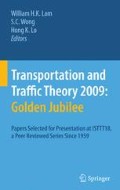Abstract
Estimation of the parameters in network equilibrium models, including OD matrix elements, is essential when applying the models to real-world networks. Link flow data are convenient for estimating parameters because it is relatively easy for us to obtain them. In this study, we propose a maximum likelihood method for estimating parameters of network equilibrium models using link flow data, and derive first and second derivatives of the likelihood function under the equilibrium constraint. Using the likelihood function and its derivatives, t-values and other statistical indices are provided to examine the confidence interval of estimated parameters and the model’s goodness-of-fit. Also, we examine which conditions are needed for consistency, asymptotic efficiency, and asymptotic normality for the maximum likelihood estimators with non-I.I.D. link flow data. In order to investigate the validity and applicability, the proposed ML method is applied to a simple network and the road network in Kanazawa City, Japan.
Access this chapter
Tax calculation will be finalised at checkout
Purchases are for personal use only
Preview
Unable to display preview. Download preview PDF.
References
Anas, A. and Kim, I. (1990). Network loading versus equilibrium estimation of the stochastic route choice model: maximum likelihood and least squares revisited. Journal of Regional Science, 30, 89-103.
Bell, M.G.H. (1991). The estimation of origin-destination matrices by constrained generalised least squares. Transportation Research Part B, 25, 13-22.
Cascetta, E. (1984). Estimation of trip matrices from traffic counts and survey data: a generalized least squares estimator. Transportation Research Part B, 18, 289-299.
Chen, M. and Alfa, A. (1991). A network design algorithm using a stochastic incremental traffic assignment approach. Transportation Science, 25, 215-224.
Clark, S.D and Watling, D.P. (2002). Sensitivity analysis of the probit-based stochastic user equilibrium assignment model. Transportation Research Part B, 36, 617-635.
Clark, S.D. and Watling, D.P. (2005). Modelling network travel time reliability under stochastic demand. Transportation Research Part B, 39, 119-140.
Daganzo, C.F. (1977). Some statistical problems in connection with traffic assignment. Transportation Research Part B, 11, 385-389.
Davis, G.A. (1994). Exact local solution of the continuous network design problem via stochastic user equilibrium assignment. Transportation Research Part B, 28, 61-75.
Durrett, R. (1991). Probability: Theory and Examples. Pacific Grove, CA.: Wadsworth and Brooks/Cole.
Fiacco, A. (1983). Introduction to Sensitivity and Stability Analysis in Nonlinear Programming. New York: Academic Press.
Fisk, C. (1977). Note on the maximum likelihood calibration on dial’s assignment method. Transportation Research Part B, 11, 67-68.
Kendall, M. and Stuart, A. (1977). The Advanced Theory of Statistics, Vol. 1, Distribution Theory. 4th edition, London: Charles Griffin.
Hazelton, M.L. (2000). Estimation of origin-destination matrices from link flows under uncongested networks. Transportation Research Part B, 34, 549-566.
Lehmann, E.L. and Casella, G. (1998). Theory of Point Estimation. Berlin: Springer.
Liu, S.S. and Fricker, J.D. (1996). Estimation of a trip table and the θ Parameter in a stochastic network. Transportation Research Part A, 30, 287-305.
Lo, H.P. and Chan, C.P. (2003). Simultaneous estimation of an origin-destination matrix and link choice proportions using traffic counts. Transportation Research Part B, 37, 771-788.
Nie, Y., Zhang, H.M. and Recker W.W. (2005). Inferring origin-destination trip matrices with a decoupled GLS path flow estimator. Transportation Research Part B, 39, 497-518.
Robillard, P. (1974). Calibration of dial’s assignment method. Transportation Science, 8, 117-125.
Stuart, A., Ord, J.K. and Arnold, S. (1999). Kendall’s Advanced Theory of Statistics, Vol. 2A, 6th edition, London: Arnold Publisher.
Yai, T., Iwakura, S. and Morichi, S. (1997). Multinomial robit with structured covariance for route choice behavior. Transportation Research Part B, 31, 195-207.
Yang, H., Sasaki, T. and Iida, Y. (1992). Estimation of origin-destination matrices from link traffic counts on congested networks, Transportation Research Part B, 26, 417-434.
Yang, H., Meng, Q. and Bell, M.G.H (2001). Simultaneous estimation of the origin-destination matrices and travel-cost coefficient for congested networks in a stochastic user equilibrium. Transportation Science, 35, 107-123.
Ying, J.Q. and Yang, H. (2005). Sensitivity analysis of stochastic user equilibrium flows in a Bi-Modal network with application to optimal pricing. Transportation Research Part B, 39, 769-795.
Acknowledgments
I would like to express my gratitude to Prof. Jun-ichi Takayama (Kanazawa University) for providing valuable comments and advices. I am also grateful to Mr. Tomonari Anaguchi (Kanazawa University) for his computational support.
Author information
Authors and Affiliations
Editor information
Editors and Affiliations
Rights and permissions
Copyright information
© 2009 Springer-Verlag US
About this chapter
Cite this chapter
Nakayama, S., D., R. (2009). Estimation of Parameters of Network Equilibrium Models: A Maximum Likelihood Method and Statistical Properties of Network Flow. In: Lam, W., Wong, S., Lo, H. (eds) Transportation and Traffic Theory 2009: Golden Jubilee. Springer, Boston, MA. https://doi.org/10.1007/978-1-4419-0820-9_3
Download citation
DOI: https://doi.org/10.1007/978-1-4419-0820-9_3
Published:
Publisher Name: Springer, Boston, MA
Print ISBN: 978-1-4419-0819-3
Online ISBN: 978-1-4419-0820-9
eBook Packages: Business and EconomicsBusiness and Management (R0)

